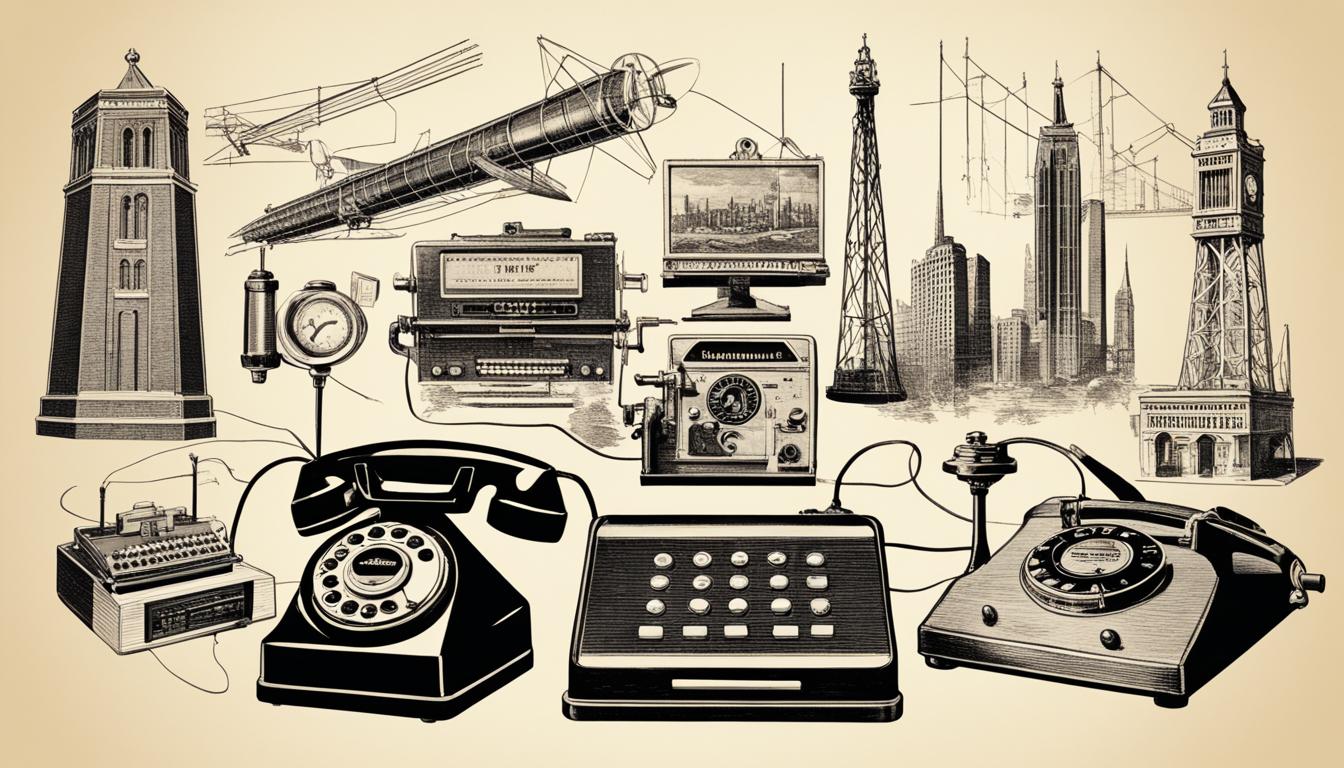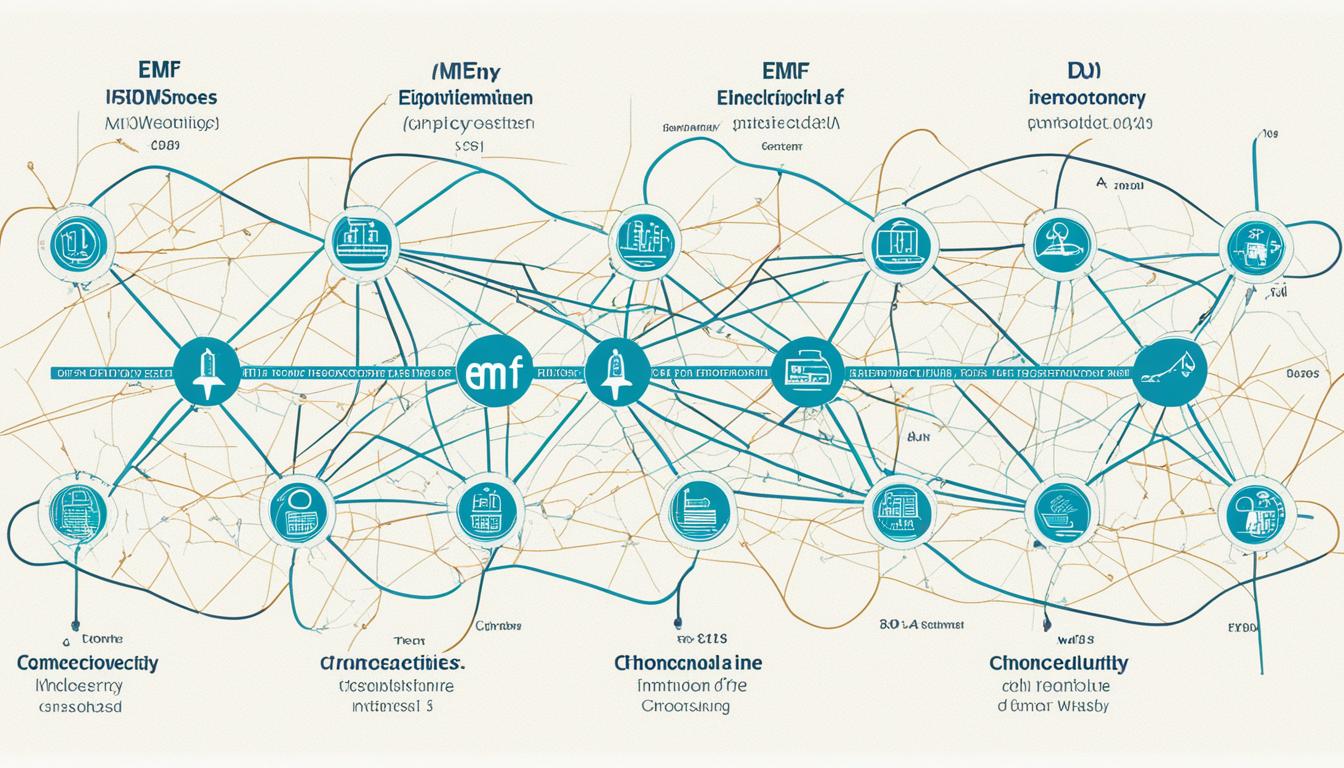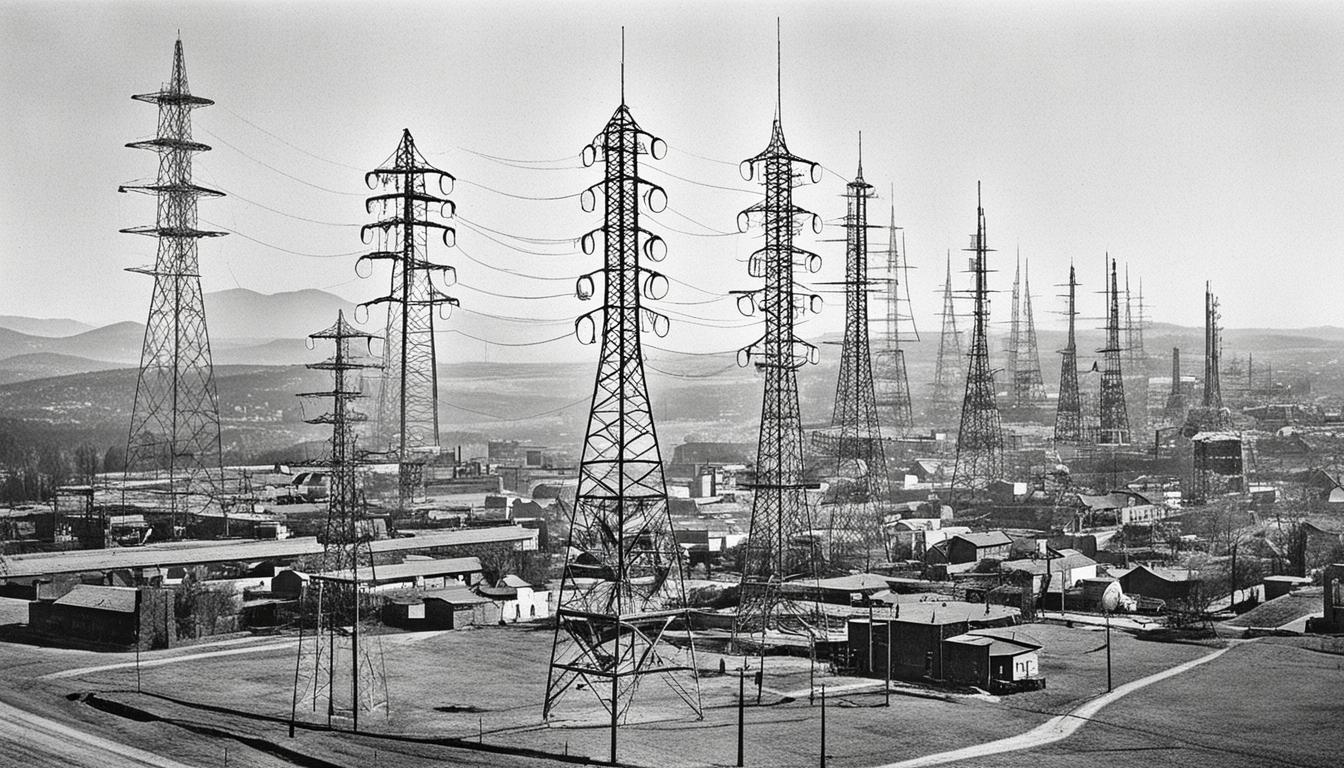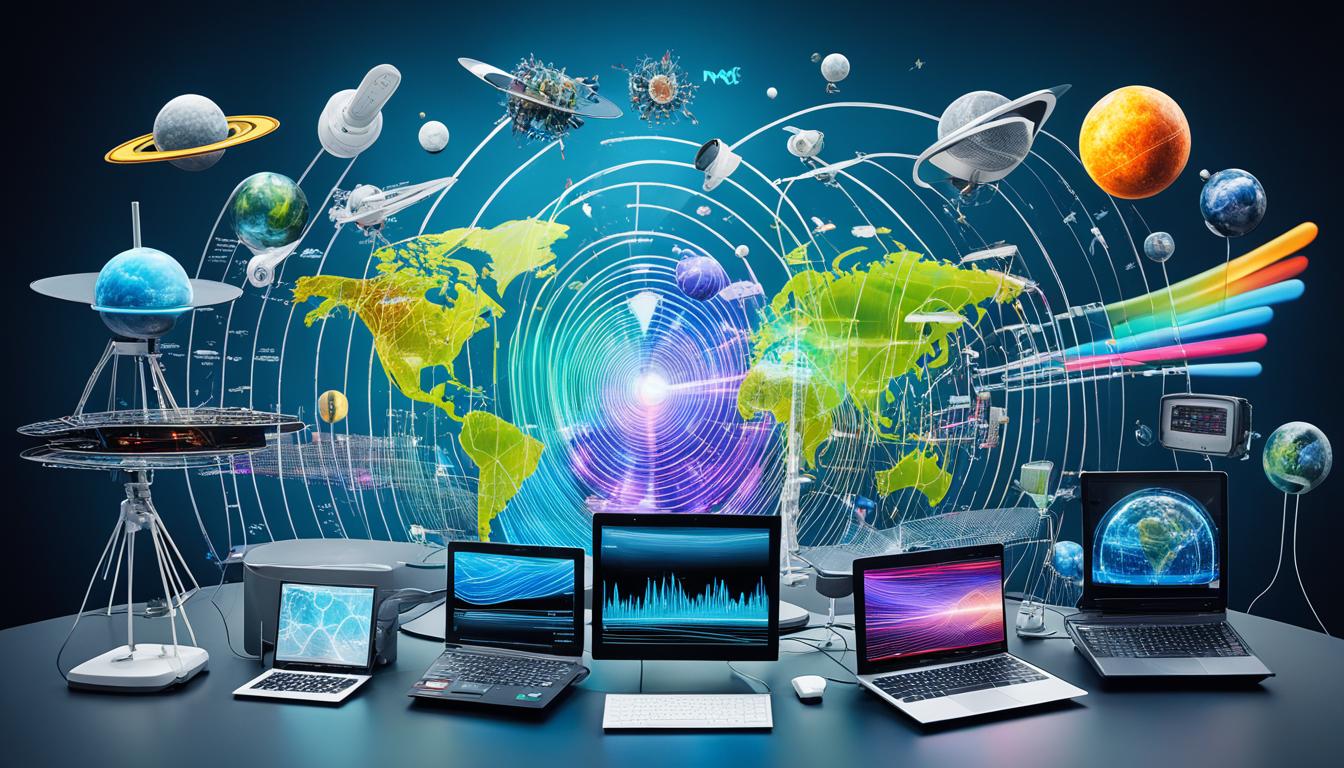Disclosure: This Post Contains Affiliate Links; We earn a commission on purchases.
The history of electromagnetic fields (EMFs) in communication is rich and extensive, spanning centuries of innovation and technological advancements. From the early understanding of electric and magnetic phenomena to the development of wireless communication and the internet, EMFs have played a crucial role in connecting people across vast distances.
Ancient civilizations, like the Greeks, conducted experiments with static electricity and discovered the remarkable properties of amber. These early discoveries laid the foundation for our understanding of EMFs in communication.
In the 17th and 18th centuries, inventors like Alessandro Volta and Benjamin Franklin pushed the boundaries of electric and magnetic fields, leading to advancements in direct and alternating current technologies.
Heinrich Hertz’s discovery of Hertzian waves in the late 19th century paved the way for the birth of wireless communication. This breakthrough led to the development of telegraphy, radio, and wireless telephony.
The invention of the telephone by Alexander Graham Bell revolutionized voice communication, followed by the introduction of television. In more recent years, mobile phones and the internet have transformed communication methods, enabling instant messaging, email, and global information sharing.
The impact of EMFs in communication cannot be overstated. EMFs are used in various applications, such as broadcast, television, satellite communication, and wireless data traffic. The global reach of EMF communication has connected people from all corners of the world, transforming society as a whole.
Key Takeaways:
- EMFs have been used in communication since ancient times, with early discoveries of static electricity and magnetic fields.
- The development of electric and magnetic fields led to advancements in technologies such as the telegraph and electric lights.
- Heinrich Hertz’s discovery of Hertzian waves laid the foundation for wireless communication.
- The invention of the telephone, television, mobile phones, and the internet transformed communication methods.
- EMFs have had a profound impact on society, enabling global communication networks and various applications.
Ancient Roots of EMF in Communication
The history of electromagnetic fields (EMFs) in communication can be traced back to ancient times, where early discoveries and experiments laid the foundation for our understanding today. Ancient civilizations like the Greeks and the Chinese made significant contributions to the study of EMFs.
The Nature of Amber and Static Electricity Experiments
As early as 500 B.C., the ancient Greeks conducted experiments with amber and discovered its unique property of attracting small objects through static electricity. This phenomenon was observed when amber, a fossilized tree resin, was rubbed with fur or cloth, generating an electrical charge. The Greeks were fascinated by this extraordinary behavior and named it “electron,” which is the root word for “electricity” that we use today. These pioneering experiments with amber provided valuable insights into the behavior of static electricity and its potential applications in communication.
The Use of Magnetic Currents in Ancient China
Around 3,000 years ago, in ancient China, magnetic currents were already being harnessed for practical purposes. The ancient Chinese recognized the magnetic field of the Earth and utilized it as a compass, aiding in navigation and exploration. By aligning with the Earth’s magnetic field, sailors and travelers were able to navigate accurately, marking a significant milestone in the ancient history of EMF communication.
These early discoveries and experiments with static electricity and magnetic currents formed the basis of our understanding of EMFs in communication. They laid the groundwork for future advancements and the development of technologies that revolutionized the way we connect and communicate with each other.
Development of Electric and Magnetic Fields
In the 17th and 18th centuries, significant advancements were made in the development of electric and magnetic fields, revolutionizing the world of technology and communication. Let’s explore some key milestones in this fascinating journey.
Alessandro Volta’s Voltaic Pile
One of the major breakthroughs during this period was Alessandro Volta’s invention of the voltaic pile. This chemical power source enabled the generation of direct currents, marking a significant step forward in the understanding and utilization of electric and magnetic fields.
Unleashing the Power of Direct Current
The development of the voltaic pile paved the way for various applications of direct current technology. Electric lights, power generators, and electric motors became feasible, enabling the growth of industries and transforming the way we live and work.
Benjamin Franklin and the Lightning Conductor
Another key figure in the development of electric and magnetic fields was Benjamin Franklin. His invention of the lightning conductor, based on his understanding of electricity, provided a means of safely conducting and dissipating electrical charges, protecting structures from lightning strikes.
Luigi Galvani and Electrical Processes in Living Beings
Luigi Galvani’s experiments on electrical processes in living beings further expanded our understanding of electric and magnetic phenomena. His famous “frog’s leg” experiment demonstrated the existence of bioelectricity, laying the foundation for future advancements in medical and biological fields.
Maxwell’s Equations: Unifying Electric and Magnetic Phenomena
James Clerk Maxwell’s groundbreaking work on electromagnetic theory, encapsulated in his set of equations, provided a unifying framework for understanding electric and magnetic phenomena. This milestone in scientific discovery laid the foundation for a solid understanding of all electromagnetic processes.
Through the development of electric and magnetic fields, inventors and scientists have propelled humanity into a new era of technological advancement. The discoveries made during the 17th and 18th centuries have paved the way for groundbreaking innovations in communication, energy generation, and countless other fields.
Birth of Wireless Communication
The birth of wireless communication can be attributed to the discovery of Hertzian waves by Heinrich Hertz in the late 19th century. Hertz successfully transmitted electromagnetic waves wirelessly, validating Maxwell’s theory of electromagnetism. This breakthrough led to the development of telegraphy and the invention of radio by Guglielmo Marconi.
Marconi’s wireless telegraphy allowed for the transmission of Morse code signals over long distances. Subsequently, the transmission of wireless telephony (voice) across the Atlantic Ocean and the world’s first wireless broadcast (voice and music) occurred, further advancing wireless communication technologies.
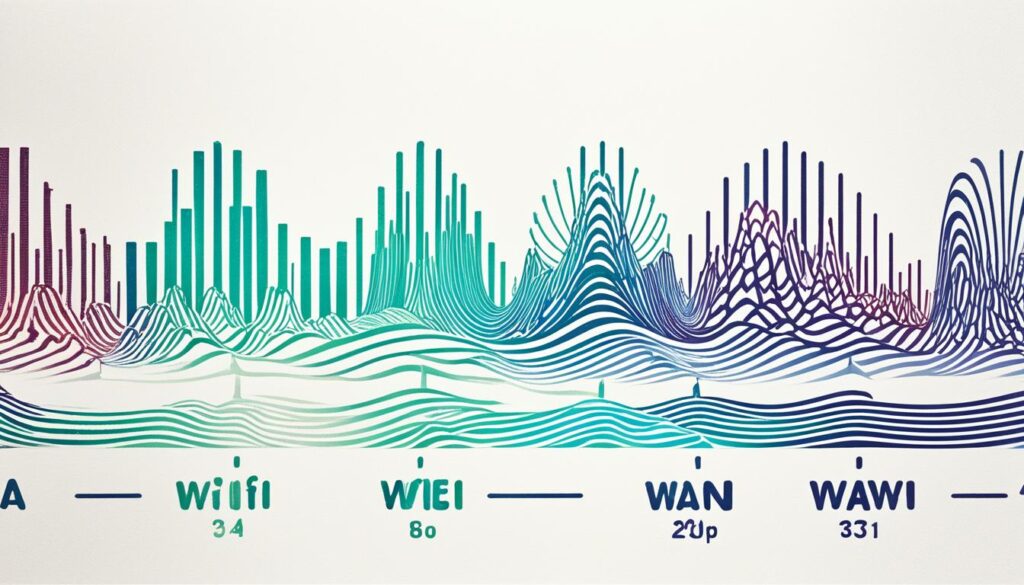
Advancements in Wireless Communication
Wireless communication has revolutionized the way we connect and communicate. The development of wireless technologies has enabled us to stay connected even when we’re on the move.
“Wireless communication has eliminated the restrictions of wires and cables, allowing us to communicate effortlessly across vast distances.”
With the advent of wireless telephony, people could now communicate using their voices rather than just Morse code. This opened up new possibilities for real-time communication and paved the way for further advancements in wireless technology.
Impact on Society
The birth of wireless communication has had a profound impact on society. It has enabled us to communicate with people across the globe, breaking down physical barriers and bringing people closer together.
- Improved accessibility: Wireless communication has made communication more accessible to people in remote areas and underdeveloped regions.
- Efficient and convenient: Wireless communication provides convenience and efficiency, allowing us to stay connected anytime and anywhere.
- Global connectivity: The advancements in wireless communication have created a global network, connecting people from different parts of the world.
As technology continues to evolve, wireless communication will continue to play a pivotal role in shaping the future of communication.
Evolution of Communication Technologies
The evolution of communication technologies has witnessed significant advancements that have revolutionized the way we connect and interact with one another. From the groundbreaking invention of the telephone by Alexander Graham Bell to the advent of the internet and satellite communication systems, the world has experienced a remarkable transformation in the way information is transmitted and received.
The telephone, introduced in the late 19th century, revolutionized voice communication by enabling individuals to connect with each other instantly. This breakthrough invention paved the way for the establishment of telephone lines, switchboards, and telephone exchanges, making voice conversations more accessible and widespread.
Following the success of the telephone, the invention of radio brought visual communication to the forefront. The development of television further enhanced the way people received and consumed information, allowing for the transmission of moving images and audio signals. It revolutionized entertainment, news dissemination, and mass communication.
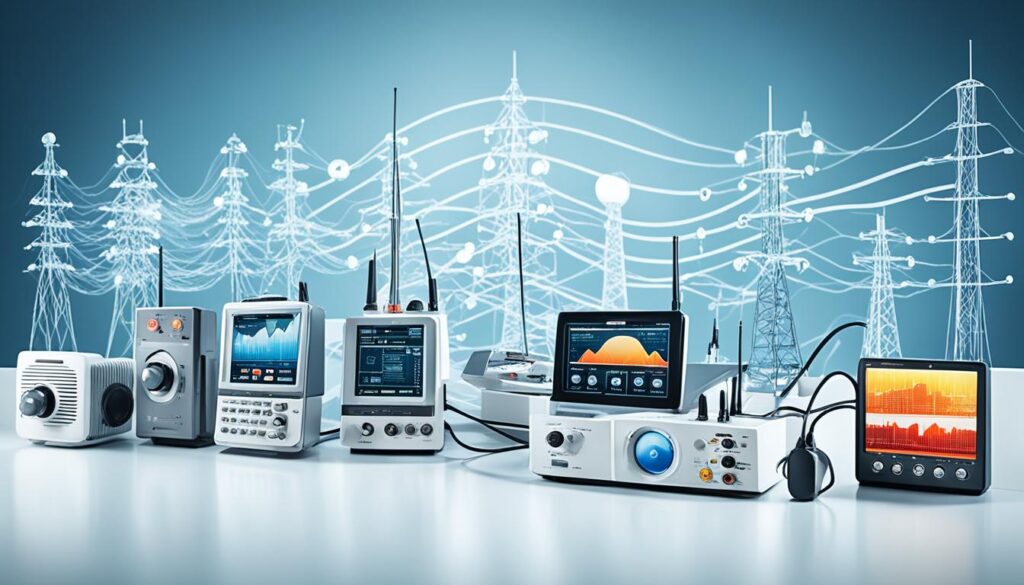
In the late 20th century, the world witnessed yet another groundbreaking development with the invention of mobile phones. These handheld devices facilitated wireless communication on the go, enabling people to connect with others regardless of their location. Mobile phones revolutionized not only voice communication but also introduced features such as text messaging and basic internet browsing.
However, the true revolution in communication came with the advent of the internet. This innovation transformed the way we communicate, allowing for instant messaging, email correspondence, and the sharing of information globally. The internet opened up new possibilities for connectivity, collaboration, and access to knowledge, making the world more interconnected and bridging geographical gaps.
Additionally, satellite communication systems and the use of optic fiber as a carrier of electronic information have played pivotal roles in further improving communication methods. Satellite communication enables long-distance communication through the use of orbiting satellites, expanding the reach of communication networks. Optic fiber, on the other hand, provides high-speed data transmission by using light signals to carry information over long distances.
These advancements in communication technologies have transformed the way society functions, making communication more efficient, accessible, and global in reach. They have reshaped industries, revolutionized entertainment, and facilitated the exchange of information on an unprecedented scale.
Evolution of Communication Technologies
| Communication Technology | Key Milestones |
|---|---|
| Telephone | Invention by Alexander Graham Bell, establishment of telephone lines, switchboards, and telephone exchanges |
| Radio | Invention of radio, development into television for visual communication |
| Mobile Phones | Invention of mobile phones, enabling wireless communication on the go |
| Internet | Advent of the internet, facilitating instant messaging, email, and global sharing of information |
| Satellite Communication | Establishment of satellite communication systems to enable long-distance communication |
| Optic Fiber | Use of optic fiber for high-speed data transmission |
The evolution of communication technologies continues to shape our society and pave the way for further advancements. As technology progresses, we can expect more innovations that will push the boundaries of communication and connect us in ways we could never have imagined.
Impact of EMFs in Communication
The impact of electromagnetic fields (EMFs) in communication has been nothing short of revolutionary. The development of technologies harnessing EMFs has transformed the way people communicate, enabling the exchange of information and ideas across vast distances. EMFs are utilized in various applications, including communication, navigation, remote control, therapeutic treatments, and the transmission of sound, images, and data.
One significant area where EMFs have played a pivotal role is in the broadcast and telecommunications industry. The use of EMFs in applications such as radio, television, radar, and satellite communications has revolutionized the way information is disseminated and received. These technologies have extended the global reach of communication, allowing individuals worldwide to stay connected and informed.
Moreover, the advent of wireless data traffic has further expanded the impact of EMF communication. The global number of mobile radio connections has skyrocketed, connecting individuals across countries and continents. The widespread availability of digital radio applications has also seen unprecedented success, providing consumers with a plethora of options to access news, entertainment, and educational content.
EMFs have transformed the communication landscape, connecting individuals worldwide and enabling the seamless exchange of information across different mediums.
The impact of EMFs in communication cannot be understated. The development and global reach of EMF communication have had a profound effect on society, bridging gaps, fostering collaboration, and enhancing the accessibility of information. As technology continues to evolve, the influence of EMFs in communication will undoubtedly shape the future of how we connect and interact with one another.
Advantages of EMFs in Communication
EMF communication offers a multitude of advantages that have significantly contributed to its global adoption and success:
- Ability to transmit information over long distances, enabling global connectivity
- Enhanced efficiency and speed of communication, facilitating real-time interactions
- Wide range of applications, including broadcast, navigation, and wireless data transfer
- Reliable transmission of sound, images, and data, ensuring clear and accurate communication
- Flexibility in choosing communication mediums, providing diverse options for user preferences
- Constant advancements in technology, leading to improved quality and accessibility
These advantages highlight the significance of EMFs in communication history and emphasize their role in shaping the modern world.
The Growing Role of EMF Communication
As the global reliance on communication technology continues to increase, so does the significance of EMF communication. The demand for seamless connectivity and the exchange of information across diverse platforms will fuel further development and innovation in this field.
With the ongoing advancements in EMF technology, we can expect the evolution of communication to push boundaries and break barriers. From the expansion of wireless networks to the integration of artificial intelligence and the internet of things, EMF communication will remain at the forefront of enabling global connectivity.
The Future of EMF Communication
The future of EMF communication holds immense potential for further advancements and transformation. As technology evolves, we can anticipate:
- Increased efficiency and speed of data transmission, enabling near-instantaneous communication
- Enhanced connectivity and coverage, reaching even the most remote areas
- Integration of EMF communication with emerging technologies, such as virtual reality and augmented reality
- Continued miniaturization of devices, facilitating the development of wearable communication technology
These exciting possibilities demonstrate the enduring impact of EMF communication and its ability to shape the way we connect and communicate in the future.
| Advantages of EMFs in Communication |
|---|
| Ability to transmit information over long distances |
| Enhanced efficiency and speed of communication |
| Wide range of applications |
| Reliable transmission of sound, images, and data |
| Flexibility in choosing communication mediums |
| Constant advancements in technology |
The image above visually represents the impact of EMFs on communication, showcasing the interconnectedness of different devices and people around the world.
Conclusion
The history of electromagnetic fields (EMFs) in communication has witnessed remarkable developments and transformations over the centuries. From the ancient use of static electricity and magnetic fields to the advent of wireless communication, telegraphy, radio, and digital technologies, EMFs have played a vital role in connecting people across vast distances.
The impact of EMFs in communication is evident in the global reach of communication networks and the wide range of applications they enable. From broadcast and television to satellite communications and wireless data traffic, EMFs have revolutionized the way we exchange information. The exponential growth of mobile radio connections and the success of digital radio applications are a testament to the significance of EMFs in communication history.
As technology continues to evolve, the history of EMFs in communication will continue to shape the future of how we connect and communicate. The ongoing advancements in EMF technologies hold the potential for even more transformative changes in the way we communicate, allowing for faster and more efficient data transmission, enhanced connectivity, and increased global accessibility. The journey of EMFs in communication is far from over, and its story will continue to unfold with each new innovation.
Source Links
- https://www.emf-portal.org/en/cms/page/home/technology/general/historical-review
- https://www.ewh.ieee.org/reg/7/millennium/radio/radio_radioscientist.html
- https://isavit-blog.medium.com/history-of-communication-ab61216cbf76

Subscribe to Our Newsletter

